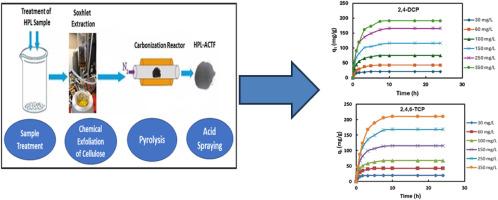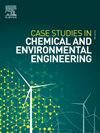Kinetics, adsorption mechanism, and economic viability of an eco-friendly amorphous carbon thin-film adsorbent synthesized from agricultural waste for removal of 2,4-dichlorophenol and 2,4,6-trichlorophenol in water environment
Q1 Environmental Science
Case Studies in Chemical and Environmental Engineering
Pub Date : 2025-07-28
DOI:10.1016/j.cscee.2025.101268
引用次数: 0
Abstract
This study developed a new adsorbent (HPL-ACTF) from agricultural waste, specifically leaves of Hamelia patens Jacq. The batch experiment examined the operating conditions including pH, temperature, contact time, and adsorbate concentrations to determine the maximum adsorption potential. The novel adsorbent demonstrated the adsorption capacities of 273.25 mg/g for 2,4,6-TCP and 232.47 mg/g for 2,4-DCP. The adsorption characteristics were evaluated using Langmuir, Freundlich, and Temkin isotherm models. The Langmuir model provided the best fit for both adsorbates. Kinetic analysis indicated that adsorption followed a pseudo-second-order model, and regeneration studies confirmed that HPL-ACTF could be effectively reused for up to five cycles.

农业废弃物合成无定形碳薄膜吸附剂去除水中2,4-二氯酚和2,4,6-三氯酚的动力学、吸附机理及经济可行性
本研究以农业废弃物为原料,开发了一种新型吸附剂(高效液相色谱- actf)。批量实验考察了pH、温度、接触时间和吸附质浓度等操作条件,以确定最大吸附势。该吸附剂对2,4,6- tcp的吸附量为273.25 mg/g,对2,4- dcp的吸附量为232.47 mg/g。采用Langmuir、Freundlich和Temkin等温模型对吸附特性进行了评价。Langmuir模型对这两种吸附都提供了最好的拟合。动力学分析表明,HPL-ACTF的吸附符合准二级模型,再生研究证实,HPL-ACTF可有效重复使用多达5个循环。
本文章由计算机程序翻译,如有差异,请以英文原文为准。
求助全文
约1分钟内获得全文
求助全文
来源期刊

Case Studies in Chemical and Environmental Engineering
Engineering-Engineering (miscellaneous)
CiteScore
9.20
自引率
0.00%
发文量
103
审稿时长
40 days
 求助内容:
求助内容: 应助结果提醒方式:
应助结果提醒方式:


